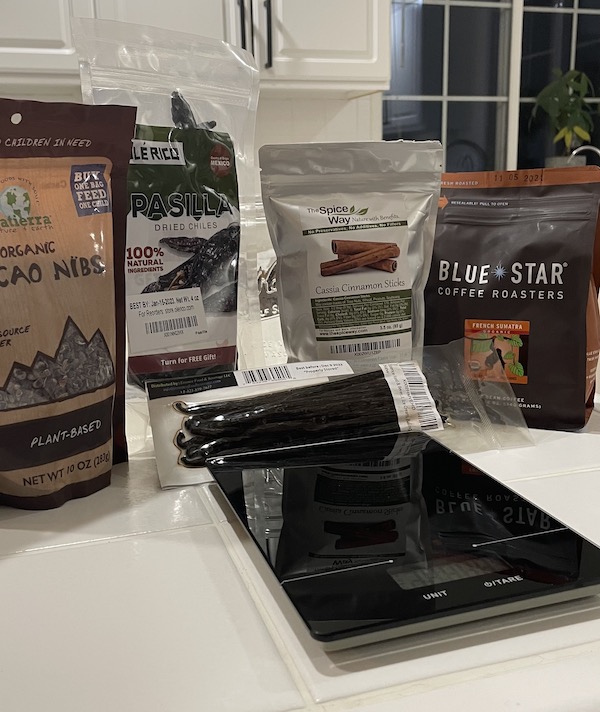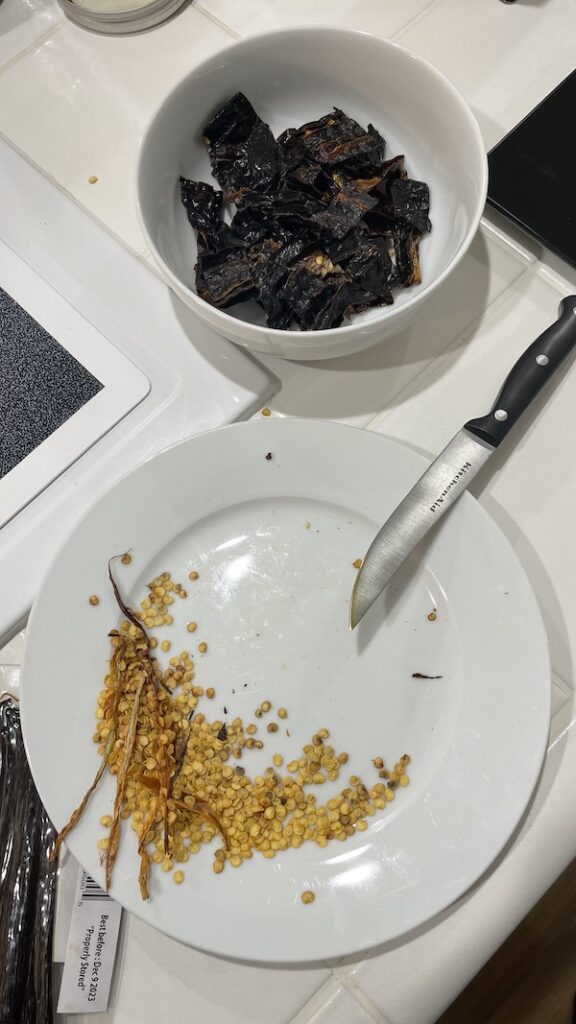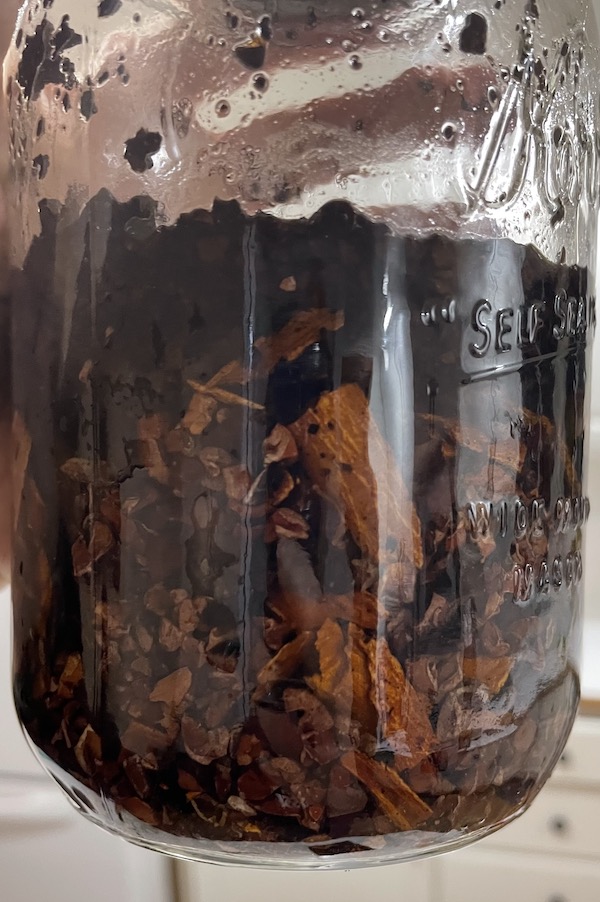I’m excited you’re here! This Mexican Hot Chocolate Stout is one of my favorite recipes that I brew. The way the roast from the barley and coffee come together with the subtle heat from pasilla chiles and sweetness from the cacao nibs and vanilla, this one is a must brew! Let me walk you through my Mexican Hot Chocolate Stout BIAB recipe!
What Makes a Mexican Hot Chocolate Stout?
As they often do, this idea stemmed from a wonderful beer put out by Stone Brewing called Xocoveza. The story behind this beer makes it that much more interesting to myself as a homebrewer. Stone has had annual homebrew competitions, and Chris Banker won the competition with this beer. In 2014, Stone put this beer out commercially, and people loved it so much, it has become a staple that Stone brews annually! How cool is that?
I would not necessarily goes as far as to say that my recipe is meant to be a clone of Stone’s Xocoveza, but it drew much inspiration from this wonderful beer!
The draw of this beer comes from the multiple layers of aroma and flavor stacked on top of each other. Generally what you encounter first in the aroma is the spiciness from the cinnamon and chiles, upon the first drink, cocoa and vanilla shine through without overpowering the palette, there is some subtle heat from the chiles that comes through at the finish but this is balanced well with the roast from the barley and coffee.
How to Brew a Mexican Hot Chocolate Stout
The first step in brewing this beer is starting with a solid base stout. To accomplish this, I like to use a bit more Maris Otter pale malt than 2-row. Maris Otter provides a more fuller palette and some biscuit-flavor to the beer. To get the color and roastiness necessary for a stout, I like to use a small amount of chocolate malt, black patent malt, and roasted barley. The addition of roasted barley, after all, is the main difference between a stout and a porter, right?
Keep the hop bill fairly neutral. Hops are not the selling point of this beer. I use small amounts of Challenger and East Kent Golding. This is a strong stout, so it does require a decent amount of bitterness to keep it balanced.
As with the hops, the yeast character is not where you want this beer to stand out. I prefer to use the classic S-04 for most of my stouts.
Okay, so now we have a great stout, but we need to take the next step to get all the cocoa, vanilla, chile, cinnamon, and coffee notes that make this beer unique.
How to Make a Tincture for Beer
The most efficient and simple way to get these flavors in your beer is by making a tincture. A tincture is simply made by soaking your ingredients in alcohol for an extended period of time. I prefer to use vodka for my tinctures as it tends to be the most neutral.
Step One:
Gather your ingredients for the tincture:
- 1.1oz (30 grams) Pasilla Peppers
- 0.42oz (12 grams) Cassia Bark (or Cinnamon)
- 1 Vanilla Bean
- 3oz (85 grams) Cacao Nibs
- 1oz (28.3 grams) Local Coffee
- One pinch Nutmeg
- Vodka

Step Two:
Carefully cut open pasilla peppers, take off the stem, and remove the seeds. Cut the peppers into smaller strips/pieces.
Carefully cut open the vanilla bean to expose those tasty insides!
Coarsely grind your coffee. If you don’t have a coffee grinder, you can simply place the measured amount of coffee in a Ziploc bag and crush with a mallet, bottom of a glass, etc.
If you have cinnamon or cassia sticks, I recommend coarsely crushing these as well.

Step Three:
Place all ingredients in a container that you’re able to seal. I prefer to use mason jars.
Add vodka until it is just covering your ingredients. I recommend using a light hand with the vodka. You will be adding this alcohol to your beer later, and you likely don’t want your beer tasting like a mixed drink!

Step Four:
Wait.
I like to let the ingredients soak for at least one week prior to adding to your beer. If you remember to make the tincture on brew day or even soon after, the ingredients will get a nice soak while fermentation occurs.
Step Five:
Add this to your beer.
Now, this is where there is some debate. Some brewers prefer to add just the liquid portion of the tincture to the fermented beer. Others prefer to add the whole jar, both liquid and solids. My decision is generally based on time. If the tincture has been sitting for at least one week, I like to just add the liquid portion. This is a much simpler and cleaner way of doing it. I feel that the beer itself likely won’t be able to extract too much more flavor from the ingredients than the vodka did if it has sat for 1+ weeks.
However, if your planning was not ideal, and you were only able to let your ingredients sit in the vodka for a couple days, I would recommend adding all of your ingredients and the vodka to your beer. Use a sanitized hop bag to place your solid ingredients in to keep things clean.
Now let’s get to the recipe! This recipe is for a two gallon BIAB batch. It can be scaled up as much as you need to for a larger BIAB or all-grain batch!
Mexican Hot Chocolate Stout Recipe
Stats:
Volume: 2 gallons (7.6L)
Predicted SRM 50
Predicted IBU 63.29
Original Gravity 1.080
Final Gravity 1.025
ABV- 7.3% (will be higher depending on how much vodka with the tincture you add)
Grain:
2.5lb (1.13 kg) 2-row
3.5lb (1.59 kg) Maris Otter Pale
8oz (226.8 grams) Crystal 60L
6oz (170.1 grams) Black Patent
4oz (113.4 grams) Chocolate Malt
4oz (113.4 grams) Roasted Barley
4oz (113.4 grams) Flaked Oats
2oz (56.7 grams) Brown Malt
Hops:
0.75oz (21.3 grams) Challenger (60 minutes)
0.5oz (14.2 grams) East Kent Golding (5 minutes)
Other Additions:
1oz (28.3 grams) Local Honey (30 minutes)
1.1oz (30 grams) Pasilla Peppers
0.42oz (12 grams) Cassia Bark (or Cinnamon)
1 Vanilla Bean
3oz (85 grams) Cacao Nibs
1oz (28.3 grams) Local Coffee
One pinch Nutmeg
OPTIONAL: Peanut Butter (discussed below)
Water:
Reverse Osmosis Water
4 grams CaCl
1 gram Gypsum
Yeast:
Safale S-04 (1/2 packet)
Directions:
Heat 10 quarts (9.5L) of strike water to 162°F (72.2C). Add brewing salts. Mill the grains and mix with strike water to reach a mash temperature of 152°F (66.7C). Hold mash temperature for 60 minutes. Sparge the grains with 170°F (76.7C) water until you reach a volume of 3 gallons (11.4) of wort. Boil for 60 minutes, following the hop schedule. Add honey at 30 minutes.
After the boil, chill the wort to slightly below fermentation temperature, about 64°F (17.8C). Aerate the wort and pitch the yeast. Ferment at 64-68°F (17.8-20C) for 2 weeks, then cold crash the beer to 35°F (1.7C). Add tincture addition after one week of fermentation. You may also add this at bottling or kegging. Bottle or keg the beer and carbonate to approximately 2.25 volumes of CO2.
Tips:
Add Lactose
Lactose is a non-fermentable sugar. So, unlike the sugars extracted from the grain, and other sugars like dextrose or honey, lactose will not be turned into alcohol by the yeast. Lactose will add residual sweetness and body to your beer. I, personally, am not a huge fan of lactose in stouts, such as ‘milk stouts’, so I left lactose out of my recipe. However, if it suits your fancy, go for it! Add approximately 6oz of lactose if you go this direction.
Add Peanut Butter
If you’re a fan of peanut butter stouts, this recipe lends very well to the addition of peanut butter! I’ve done this a couple times with this recipe, and it is delicious. I made the peanut butter addition optional in the recipe itself as I know not everyone loves a peanut butter beer. However, if this sounds interesting to you, let me explain how I usually like to add it.
How to Add Peanut Butter to Beer
Peanut butter itself is high in oil content. This presents a problem for brewing. Oils destroy your head retention. I have read about some brewers spreading classic peanut butter over a cooking sheet, and dabbing the oil that comes out over a series of days. However, if you’re like myself, you may not have time for this method.
I have had good success with using peanut butter powder. Specifically, PB2 powder seems to have the best flavor. Per each gallon of beer, boil 2.5 cups (236.6mL) of water and add this to 6.5oz (184.3 grams) of PB2 powder to form a slurry. Add this slurry to your beer after active fermentation has subsided.
Thank you for stopping by!
If you are interested in how to homebrew using the brew-in-a-bag BIAB method, please see my post here.
If you would like to see more small batch recipes like this, please follow this link.
